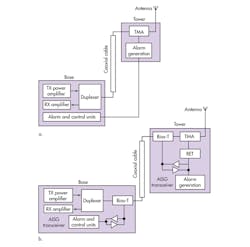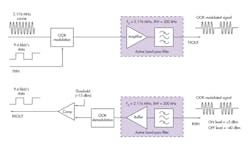State-of-the art wireless networks must provide high-speed data services to support the data-intensive applications of smart phones. Infrastructure deployment, however, is still costly and occasionally presents the reason for inadequate coverage in some areas.
To mediate these issues, the Antenna Interface Standards Group(AISG) developed an open interface protocol specification for intelligent antenna systems. It defines the digital remote control and monitoring of wireless infrastructure that dynamically optimizes a network based on changing coverage requirements. The protocol also allows for implementing a remote electric tilt (RET) function for antennas.
Related Articles
- Fiber Optic Transceivers In Basestation Applications
- High-Gain Omnidirectional Basestation Antenna Improves White Space Wireless Performance
- Handheld Spectrum Analyzers Ease Remote Basestation Maintenance
Protecting their infrastructural investments, telecommunications companies have quickly adopted this standard to become independent from proprietary solutions. Also, manufacturers of basestations and sector antennas are benefiting from a standardized technology as it increases their efficiency in product planning.
Electric Tilt In Antennas
Electrical tilt, introduced in earlier generation cellular antennas, is a method where the beam is “tilted” by altering the signal phasing. This solution offers an undistorted azimuth beam. It also provides the distinct advantage of tilting all lobes including main, rear, and side to the same measure, controlling interference in all directions.
This file type includes high resolution graphics and schematics.
Electrical tilt was somewhat limited, being available only in discrete steps. The development of modern cellular antennas, however, features adjustable electrical tilt, which allows cellular operators to continuously tilt the antenna, optimizing coverage and reducing interference without compromise. This technology has proved particularly useful for suppressing detrimental side lobe radiation.
The latest antenna designs include RET. This new technology extends the convenience of variable electrical tilt by relocating the tilt adjustment facility from the antenna body to the tower base or the network management center. Nowadays where fast and efficient network tuning is becoming critical, remote tilt technology provides substantial site optimization benefits.
Sector Antennas
A sector antenna is a type of directional microwave antenna with a sector-shaped radiation pattern. The largest use of these antennas is in cell-phone basestations. They are used for limited-range distances of around 4 to 5 km. Here, electrical tilt is set by using a special control unit, which is usually built into the antenna case.
To increase or widen the coverage area, and thus the number of served clients, several sector antennas are often installed on the same tower or mast. An optimized down-tilt setting strategy commonly reduces the overall interference in the network. Down-tilting is also used to solve local interference problems or optimizing cells that are too large.
Basestation Systems And AISG
A basestation prior to AISG introduction uses a coaxial cable for the data communication between the controlling equipment in the base and the equipment located at the antenna’s tower (Fig. 1a). Here a tower-mounted amplifier (TMA), a low-noise preamplifier that increases the signal-to-noise ratio (SNR) of the receive signal, is placed at the tower, right after the antenna, in the RF receive path.
The base includes a duplex filter separating the two different frequencies of the transmitting and receiving paths, as well as a transmission power amplifier and a receiver amplifier. Furthermore, an implemented alarm system monitors the proper operation of the tower equipment by sending alarm messages from the tower to the control equipment in the base via a separate cable.
In 2005, the wireless network 3G standard required the control and dynamic adjustment of the antenna tilt to optimize the radiated signal. This gave birth to the RET device that since has been added to the tower equipment. The AISG standard introduced shortly afterward simply ensured that the RET was driven remotely from the base using a standardized communication protocol.
Figure 1b shows a basestation complying with the AISG standard protocol. The same protocol is also used for carrying alarm information from the tower to the base. Low-frequency modulation of AISG data makes it possible to use the same coaxial cable for transmitting RF data and handling AISG signals, reducing cabling requirements. Additionally, so-called bias-T devices allow the supply voltage of typically 30 V to be carried from the base to the tower over the same cable.
AISG Application
The AISG protocol uses a 2.176-MHz sine-wave carrier with on-off-key (OOK) modulation. The communication is half-duplex with the basestation as the master and the tower as the slave. This communication changes the tilt of the antenna with commands from the basestation and monitors the status of the tower equipment.
Legacy designs of AISG transceivers were implemented discretely using various methods for OOK modulation and demodulation, as well as a wide variety of amplifiers and logic components for bus arbitration. Whatever the design approach, the final solution had to be transparent for AISG implementation.
Figure 2 illustrates a discrete transceiver design. The OOK modulator is realized with an analog switch. The stringent requirements of the AISG spectrum-emission profile, however, make a fifth- or sixth-order band-pass filter design necessary. The receive path requires the same selective filter, followed by a peak demodulator, and a comparator to reconstruct the digital data.
Overall, the discrete implementation of an AISG transceiver yielded an expensive design with high component count. A modern AISG transceiver includes all key functions on a single chip, drastically reducing component count and design time to implement the AISG protocol.
Performance Requirements
The oscillator providing a 100-ppm precise carrier frequency of 2.176 MHz requires crystal control. Thus, a solid phase-locked loop (PLL) circuit is needed, or an integer multiple of the carrier can be used. The switch, pre-amplifier, and band-pass filter must comply with a specified conducted emissions mask and the requirements on intermodulation products.
For example, the mask requires approximately 40 dB of difference between the 2.176-MHz carrier frequency and 1 MHz, a little more than an octave. Careful analog design is then required to modulate the carrier without introducing significant high-frequency components.
The output stage must provide sufficient signal amplitude into a 50-Ω load, which presents a challenge to circuit performance and the available power supply. A nominal +3-dBm signal, equivalent to 1 V p-p, could theoretically be achieved with a low supply of ±1 V or +2.5 V. To preserve the linearity necessary to comply with the emissions mask, though, the practice requires at least 3 V of supply. This level allows for sufficient biasing of the line driver circuits to avoid non-linear saturation effects. The bandwidth of the output stage must also be sufficiently wide to prevent frequency-dependent distortion of the carrier.
The input filter filters the incoming modulated signal and removes energy outside the carrier frequency. The same filter requirements apply to the output filter. The demodulation function uses an envelope detector. TS 25.461 specifies OFF levels below –18 dBm and ON levels from –12 dBm to +5 dBm. The wide dynamic range presents a design challenge due to the added constraint of less than 10% data duty cycle.
Integrated Transceiver Advantages
The key advantage of an integrated AISG transceiver is its small package size of 3 mm by 3 mm, while the board size for a discrete implementation often exceeds 400 mm2. Another advantage is the low incremental cost for protection functions such as power-on-reset (POR), thermal shutdown (TSD), and electrostatic discharge (ESD) protection.
POR keeps the modem outputs in a safe state, preventing unwanted glitches from corrupting the interfaces during power-up and power-down. The TSD shuts down the high-power output stages in the case of an overload fault. The ESD circuits divert ESD energy away from the sensitive circuits.
An advanced feature added to the integrated AISG modem is an auto-direction control output (DIR), which facilitates RS-485 communication between tower-mounted equipment. The base determines the direction of the data flow, while the tower equipment decodes the information and responds to commands from the base. The transceiver’s DIR output frees the microcontroller from managing RS-485 bus arbitration.
Normally in a low logic state, DIR goes high when a modulated signal is received via the coax line. The duration of the logic high state is configurable through three configuration inputs and corresponds to the message length, which varies with the selected network baud rate.
One more benefit of the integrated transceiver is its power supply range from 3.3 V to 5 V. A separate logic supply of down to 1.6 V is also provided to allow for interfacing with a low-volt controller, eliminating the need for external level-shifting.
Conclusion
AISG provides a standard protocol for communication between basestation and tower equipment. Integrated AISG transceiver chips provide a fully integrated solution to modulate and demodulate the OOK signal used in the protocol. These single-chip solutions save design space and cost. They also simplify the arbitration of the data flow in the tower equipment.
References
Download a datasheet for the SN65HVD62 at www.ti.com/sllse94-ca.
For more information visit www.ti.com/sn65hvd62-ca.
Thomas Kugelstadt is an applications manager with Texas Instruments. He is responsible for defining new, high-performance analog products and developing complete system solutions for industrial interfaces with robust transient protection. He is a graduate engineer from the Frankfurt University of Applied Science.
This file type includes high resolution graphics and schematics.



